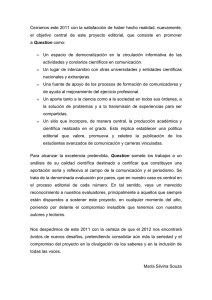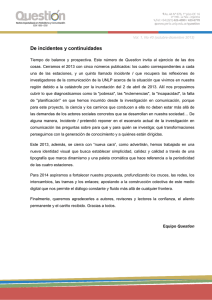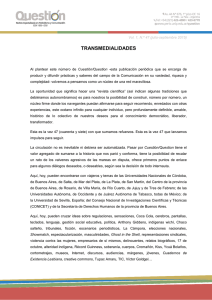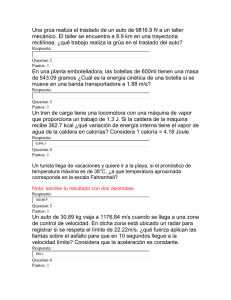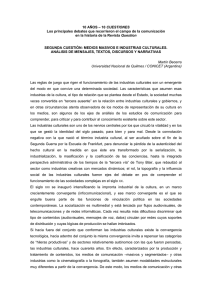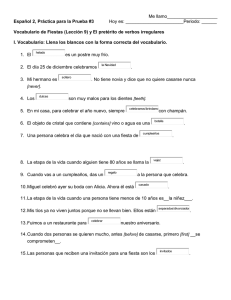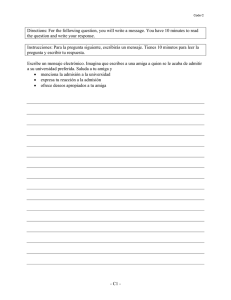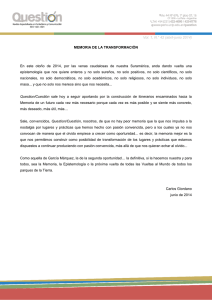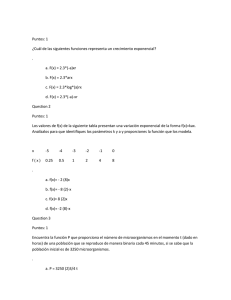Sample Questions for the College of Extend Learning Spanish/English
Anuncio
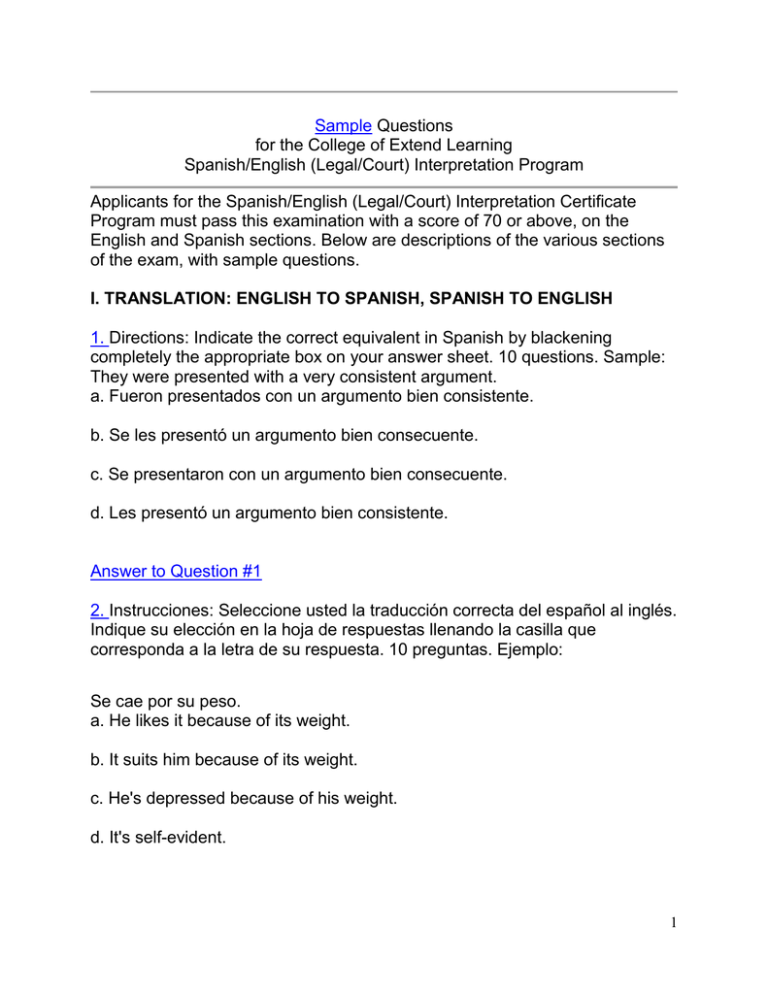
Sample Questions for the College of Extend Learning Spanish/English (Legal/Court) Interpretation Program Applicants for the Spanish/English (Legal/Court) Interpretation Certificate Program must pass this examination with a score of 70 or above, on the English and Spanish sections. Below are descriptions of the various sections of the exam, with sample questions. I. TRANSLATION: ENGLISH TO SPANISH, SPANISH TO ENGLISH 1. Directions: Indicate the correct equivalent in Spanish by blackening completely the appropriate box on your answer sheet. 10 questions. Sample: They were presented with a very consistent argument. a. Fueron presentados con un argumento bien consistente. b. Se les presentó un argumento bien consecuente. c. Se presentaron con un argumento bien consecuente. d. Les presentó un argumento bien consistente. Answer to Question #1 2. Instrucciones: Seleccione usted la traducción correcta del español al inglés. Indique su elección en la hoja de respuestas llenando la casilla que corresponda a la letra de su respuesta. 10 preguntas. Ejemplo: Se cae por su peso. a. He likes it because of its weight. b. It suits him because of its weight. c. He's depressed because of his weight. d. It's self-evident. 1 Answer to Question #2 II. VOCABULARY - SYNONYMS AND ANTONYMS 3. Instrucciones: Seleccione la palabra cuyo significado exprese lo mismo que la palabra subrayada en la oración: La muchacha disimuló su inquietud. Ejemplo: 5 preguntas. a. encubrió b. venció c. asumió d. intuyó Answer to Question #3 4. Instrucciones: Seleccione la palabra cuyo significado exprese lo contrario a la palabra subrayada en la oración: Mi abuela era una persona arisca. Ejemplo: 5 preguntas. a. tacaña b. hacendosa c. alpinista d. simpática Answer to Question #4 5. Directions: Choose the word whose meaning is the same as the underlined word in the sentence: The attorney's rebuttal proved decisive in the case. Sample: 5 questions. a. reasoning 2 b. representation c. refutation d. revelry Answer to Question #5 6. Directions: Choose the word whose meaning is the opposite of the underlined word in the sentence: His arguments were hogwash. Sample: 5 questions. a. crafty b. reasonable c. alluring d. hackneyed Answer to Question #6 III. SPANISH AND ENGLISH GRAMMAR AND SYNTAX 7. Instrucciones: Escoja la letra de la única repuesta correcta para llenar el blanco y marque la casilla correspondiente en su hoja de respuestas. 10 preguntas. Ej.: La chica se parece mucho ________________ su madre. a. en b. de c. a d. con 3 Answer to Question #7 8. Instrucciones: Marque en su hoja de respuestas la oración que no tenga ningún error. En caso de que todas estén correctamente escritas, marque la expresión "todas correctas"; si por el contrario, ninguna está correctamente escrita, marque la expresión "ninguna correcta." 10 preguntas. Ejemplo: a. Se lo habrá llevado alguna de las vendedoras. b. Llévate el paraguas por si llueve. c. Las mujeres protestaban indignadas. d. Ninguna correcta e. Todas correctas Answer to Question #1 9. Directions: Select the correct missing word and blacken the corresponding box on your answer sheet. 20 questions. Sample: _____________ he done it, it would be obvious. a. If b. Had c. In case d. Would Answer to Question #9 10. Instrucciones: Escoja la letra de la única oración que está correctamente expresada y marque la casilla correspondiente en la hoja de respuestas. 5 4 preguntas. Ejemplo: a. Tengo un profesor que han nombrado miembro de la Academia. b. Es posible que para el año 2010 hay un ordenador en todas las casas. c. Desde luego, si yo fuera hombre, no me casaría. Answer to Question #10 11. Directions: Choose the letter of the only sentence that is written correctly and blacken the corresponding box on your answer sheet. 5 questions. Sample: a. Having just been convicted of murder, the judge sentenced the accused. b. Some runaway slaves contrived to eke out an existence. c. The plane had an accident in which my parents planned to travel. Answer to Question #11 IV. READING COMPRENSION, ENGLISH AND SPANISH 12. Instrucciones: A continuación de cada pasaje se encuentra un grupo de preguntas basadas en su contenido. Después de leer el pasaje, seleccione la respuesta correcta e indíquela en la hoja de contestaciones llenando completamente la casilla que corresponde a la letra de su elección. 5 preguntas. Ejemplo: La preposición es una palabra invariable que establece una relación, de tipo distinto según la preposición, entre otras dos palabras, una de las cuales expresa un complemento de la otra; la palabra que especifica la relación, dentro del tipo determinado por la preposición, es la afectada por ésta; algunos la llaman «término»; pero esta designación es vaga, puesto que término es cualquier palabra; es mejor distinguirla como «palabra afectada por la preposición». 5 ¿Por qué prefiere la autora la expresión «palabra afectada por la preposición»? a. porque «término» se considera anticuado b. porque «término» no es suficientemente específica c. porque «término» se refiere sólo a las palabras más afectadas d. porque «término» se usa sólo para distinguir la primera palabra Answer to Question #12 13. Directions: A question follows each of the passages in this section. Using only the stated information given in the passage, answer the questions by choosing the correct answer from among the choices given. 5 questions. Sample: Let us ask the question, How can a word have meaning? Some words can be defined in terms of other words: "square" for example means "four-sided equilateral equiangular plane figure." And most of the terms in that definition can also be defined. But definitions can't be the basis of meaning for all words, or we'd go forever in a circle. Eventually we must get to some words which have meaning directly. What can we infer from the preceding paragraph? a. that words like "square" cannot really be defined accurately b. all words are ultimately dependent upon other words for their meaning c. the author doubts the existence of words with direct meaning d. in seeking how language has meaning, we cannot depend solely on words like "square" Answer to Question #13 6 ANSWERS TO SAMPLE QUESTIONS I. TRANSLATION 1. b RETURN TO QUESTION #1 2. d RETURN TO QUESTION #2 II. VOCABULARY - SYNONYMS AND ANTONYMS 3. a RETURN TO QUESTION #3 7 4. d RETURN TO QUESTION #4 5. c RETURN TO QUESTION #5 6. b RETURN TO QUESTION #6 III. SPANISH AND ENGLISH GRAMMAR AND SYNTAX 8 7. c RETURN TO QUESTION #7 8. e RETURN TO QUESTION #8 9. b RETURN TO QUESTION #9 10. c RETURN TO QUESTION #10 9 11. b RETURN TO QUESTION #11 IV. READING COMPREHENSION, ENGLISH AND SPANISH 12. b RETURN TO QUESTION #12 13. d RETURN TO QUESTION #13 10
